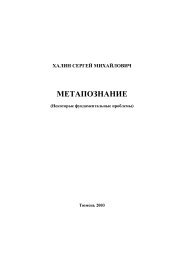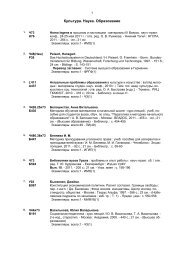The Economic History of Byzantium - Dumbarton Oaks
The Economic History of Byzantium - Dumbarton Oaks
The Economic History of Byzantium - Dumbarton Oaks
Create successful ePaper yourself
Turn your PDF publications into a flip-book with our unique Google optimized e-Paper software.
984 NICOLAS OIKONOMIDES<br />
<strong>of</strong> a cessation <strong>of</strong> trade, merely <strong>of</strong> a reduction in its frequency and importance. 26 In any<br />
case, as we shall see, the state and its representatives continued without respite to demand<br />
their share <strong>of</strong> the trade economy, however much it may have diminished.<br />
<strong>The</strong> state controlled commercial transactions through the kommerkiarioi, agents<br />
whose field <strong>of</strong> activity was trade. 27 In the sixth century, kommerkiarioi was the name<br />
given to the imperial employees who, at the Syrian border, bought on behalf <strong>of</strong> the<br />
Byzantine state the silk imported from the East. 28 Around 630, the term kommerkiarios<br />
was translated into the scholarly language as oJ th'" shrikh'" a“rcwn ejsqh'to" (“lord <strong>of</strong> the<br />
silk cloth”). 29 <strong>The</strong> number <strong>of</strong> kommerkiarioi subsequently increased significantly, and<br />
they acquired a special type <strong>of</strong> lead seal showing the emperor, an indication that the<br />
seals were placed on commodities <strong>of</strong> particular value, such as silk. On the reverse <strong>of</strong><br />
some <strong>of</strong> these seals is the imprint <strong>of</strong> the burlap from the sack containing the merchandise.<br />
Very few other <strong>of</strong>ficials used seals depicting the emperor at this time, only those<br />
who were responsible for the movement <strong>of</strong> particularly valuable goods (gold coins,<br />
purple dye, etc.). Constantinople, in particular, was the headquarters <strong>of</strong> the lords <strong>of</strong><br />
the blattion (purple), <strong>of</strong> whom we have testimony until 785/86 and who were <strong>of</strong>ten<br />
also general kommerkiarioi and overseers <strong>of</strong> workshops. In this capacity, <strong>of</strong> course, they<br />
supervised the imperial workshops where purple cloth and leather were made. <strong>The</strong>se<br />
state workshops seem to have been reorganized after a disastrous fire in 792.<br />
<strong>The</strong> fact that kommerkiarioi were to be found throughout the empire may be connected<br />
with the efforts made to encourage the production <strong>of</strong> silk and is certainly bound<br />
up with sales and purchases <strong>of</strong> silk. On the other hand, it is clear that the kommerkiarioi<br />
dealt in goods other than silk; it is impossible to imagine that while sericulture was developing<br />
in <strong>Byzantium</strong>, at a time when the economy was only partly monetized, there<br />
could be entrepreneurs who dealt exclusively in silk. 30 And <strong>of</strong> course they would use a<br />
different seal <strong>of</strong> the common type for all their transactions and correspondence when<br />
valuable items were not involved.<br />
26 Forexchange, see A. E. Laiou, “Exchange and Trade, Seventh–Twelfth Centuries,” EHB 697–708.<br />
27 H. Antoniadis-Bibicou, Recherches sur les douanes à Byzance: L’“octava,” le “kommerkion” et les commerciaires<br />
(Paris, 1963), has been supplemented by the publication <strong>of</strong> many more seals <strong>of</strong> kommerkiarioi<br />
by G. Zacos and A. Veglery, Byzantine Lead Seals (Basel, 1972). A debate ensued, in connection with<br />
which Icite the main publications and which I have taken into consideration in the discussion that<br />
follows. N. Oikonomides, “Silk Trade and Production in <strong>Byzantium</strong> from the Sixth to the Ninth<br />
Century: <strong>The</strong> Seals <strong>of</strong> Kommerkiarioi,” DOP 40 (1986): 33–53; A. Dunn, “<strong>The</strong> Kommerkiarios, the<br />
Apotheke, the Dromos, the Vardarios and the West,” BMGS 17 (1993): 3–24; see also Laiou, “Exchange<br />
and Trade,” 706, and note 31 below.<br />
28 As can clearly be seen in the novels concerning silk <strong>of</strong> the 6th century: Imp. Iustiniani PP. a.,<br />
Novellae . . . , ed. C. E. Zachariae von Lingenthal (Leipzig, 1881), 2:293.<br />
29 B. Flusin, Saint Anastase le Perse et l’histoire de la Palestine au début du VIIe siècle (Paris, 1992), 1:72<br />
n. 108.<br />
30 I find it hard to believe that the kommerkiarioi supplied weapons to Byzantine soldiers, as proposed<br />
by M. F. Hendy, Studies in the Byzantine Monetary Economy c. 300–1453 (Cambridge, 1985), 624,<br />
626–34, 654–62, followed by J. F. Haldon, <strong>Byzantium</strong> in the Seventh Century: <strong>The</strong> Transformation <strong>of</strong> a<br />
Culture (Cambridge, 1990). <strong>The</strong>re is no support in the sources for such a hypothesis. See Mercati e<br />
mercanti nell’alto medioevo: L’area euroasiatica e l’area mediterranea (Spoleto, 1993), 640 n. 13.








